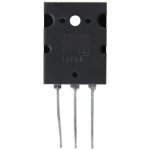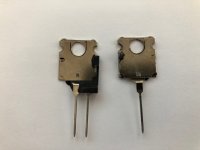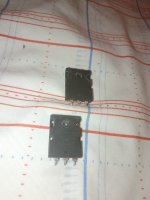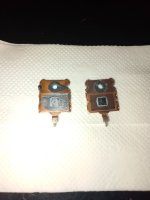I completely agree with you.
Original means special 🙂
Indian semiconductor market is completely different than American & European market. We are big country you know, great population.
Original means special 🙂
Indian semiconductor market is completely different than American & European market. We are big country you know, great population.
I personally never seen Toshiba transitors like yours,
they look different so I said they are fakes just based on the look .
But I am convinced I could be wrong.
Can you measure the capacitance B-C, B-E, C-E?
they look different so I said they are fakes just based on the look .
But I am convinced I could be wrong.
Can you measure the capacitance B-C, B-E, C-E?
I personally never seen Toshiba transitors like yours,
they look different so I said they are fakes just based on the look .
But I am convinced I could be wrong.
Can you measure the capacitance B-C, B-E, C-E?
I understand that 🙂 Anyway diyaudio mod Sangram already confirmed these tests (capacitance, weight etc).
Currently i don't have a LC meter 🙁
Best Regards.
Find a friend that does. Or buy one. I have a DMM that measures L and C (actually three of them the same). Consider it an investment in infrastructure that you NEED if your sources for transistors are iffy. Buying a $95 meter instead of the cheapest $29 available saves money in the long run if you can use it for parts screening and making crossover inductors instead of paying 3 prices for them.
If you have to ask if they are fakes then you bought from wrong seller.Hello
Break one and see what the silicon pill looks like.
Otherwise the transistor looks too good!
Who is the seller, because that says a lot.
Best regards
Only buy from reputable dealer if possible.
The picture indicate authentic component to me. However the proof of the pudding is in the eating.According to the seller only tray pack has 'Japan' marking on 2sc5200/1943 transistors & there is no mention of 'Japan' in the strip pack(see attachment). I believe these are 100% authentic, what do you think?
The best way is to check Die size by break open. If you cannot do this Just test them at load in a prototype circuit with proper circuit protection. In my openion "fake" doesnot matter much to me if they are extremely cheap and sustain at least 75% of rated specification.
Original components are not cheap. How can a seller give any authentic component at a cheaper rate than MRP?. It must be either Fake or the die manufactured by a different manufacturer.
In electronic component sourcing, the reputation of the seller is very important unless you buy it directly from the company distributer. I only trust RS for component sourcing for critical applications even if they are expensive than other sellers for 100% authenticity.
Just to clarify - The posts attributed to me are from quite a while ago, things have changed a bit over the years.
Recently when working on a Class A SE amp I procured a couple tubes which now had the 'Japan' inscription, and matching on a tube are about 5% from top to bottom. From memory, the ones without 'Japan' had identical packaging, were non-magnetic, and stood up excellently to stress testing and long-term reliability. I still don't know if they were official parts or not, as the matching was not so good. I don't remember testing capacitance either, pretty sure I didn't. Those sets are resting, because we shifted to MOSFETs.
About load testing, it's better to put them in a real circuit and check actual performance against the keantoken models used in simulation. You'll get a much better estimate of whether they are genuine, if you're not able to crack one open. Keeping a device under SOA while applying heavy loads requires some experience.
Recently when working on a Class A SE amp I procured a couple tubes which now had the 'Japan' inscription, and matching on a tube are about 5% from top to bottom. From memory, the ones without 'Japan' had identical packaging, were non-magnetic, and stood up excellently to stress testing and long-term reliability. I still don't know if they were official parts or not, as the matching was not so good. I don't remember testing capacitance either, pretty sure I didn't. Those sets are resting, because we shifted to MOSFETs.
About load testing, it's better to put them in a real circuit and check actual performance against the keantoken models used in simulation. You'll get a much better estimate of whether they are genuine, if you're not able to crack one open. Keeping a device under SOA while applying heavy loads requires some experience.
I know this is an old thread; however, I've been building amplifiers and made the mistake of buying 2SA1943/2SC5200 and TTA1943/TTC5200 from both Amazon and eBay only to find they were absolute garbage and here is what they look like:
These are the TTA1943 and TTC5200 from both these eBay sellers (see attached image of tiny little die and magnetic tin coated steel heat spreader):
https://www.ebay.com/itm/392620267303
https://www.ebay.com/itm/123356242155
The 2SA1943/2SC5200 I bought from Amazon also look identical (die size, tin coated steel vs. copper, etc) and they were from "Bridgold Direct" on Amazon here (See attached image, the image is of the TTA/TTC; however, the 2SC/2SA that I cracked open look the same so I didn't bother posting their picture):
https://www.amazon.com/gp/product/B081W6CBHX
These are the TTA1943 and TTC5200 from both these eBay sellers (see attached image of tiny little die and magnetic tin coated steel heat spreader):
https://www.ebay.com/itm/392620267303
https://www.ebay.com/itm/123356242155
The 2SA1943/2SC5200 I bought from Amazon also look identical (die size, tin coated steel vs. copper, etc) and they were from "Bridgold Direct" on Amazon here (See attached image, the image is of the TTA/TTC; however, the 2SC/2SA that I cracked open look the same so I didn't bother posting their picture):
https://www.amazon.com/gp/product/B081W6CBHX
Attachments
Amazon 
Try to get njw0281/0302G from authorised dealer, i heard that these are better performer than 2SA/SC pair although spec is almost identical.

Try to get njw0281/0302G from authorised dealer, i heard that these are better performer than 2SA/SC pair although spec is almost identical.
I ended up buying TTC5200/TTA1943 from DigiKey. They should arrive Friday. Maybe I'll break one open and post it here.
No need to, Digikey is reliable.
I also have TTA vr which is cheaper than 2SC series & good enough for typical hifi stereo amplifiers.
I also have TTA vr which is cheaper than 2SC series & good enough for typical hifi stereo amplifiers.
I have been working with these Transistors 2SC5200 and 2SA1943 with name SPTECH both. I worked on three amplifiers with them but after two of these three amplifiers got damaged because the mentioned transistors failed, I have a doubt if they are fake or not. I am sure I did the proper adjustments but I don't what to think. If somebody knows them, here a photo.. now, does a fake transistor stick to the magnet?
Attachments
One thing is for sure. It’s NOT a Toshiba. That makes it a copy, not a fake. Fakes are always bad, copies vary from as bad as fakes to somewhere in the ball park of original performance. If yours blew, I would in the future avoid SPTECH, because they are obviously not as good. I have used Fairchild’s copies, and they meet my expectations. Supposedly KEC is making them now, but the jury is out - simply not enough data yet (but their driver devices work well so thats encouraging). ISC makes copies too, but their stuff in general isn’t as good. - plenty of field failures reported.
The “magnet test” indicates steel in the leadframe. It is supposed to be copper.
The “magnet test” indicates steel in the leadframe. It is supposed to be copper.
Thanks Wg, for replying. I will open them tomorrow and I will upload some photos of the inside part of these transistors to get rid of the heavy doubt. Thanks.One thing is for sure. It’s NOT a Toshiba. That makes it a copy, not a fake. Fakes are always bad, copies vary from as bad as fakes to somewhere in the ball park of original performance. If yours blew, I would in the future avoid SPTECH, because they are obviously not as good. I have used Fairchild’s copies, and they meet my expectations. Supposedly KEC is making them now, but the jury is out - simply not enough data yet (but their driver devices work well so thats encouraging). ISC makes copies too, but their stuff in general isn’t as good. - plenty of field failures reported.
The “magnet test” indicates steel in the leadframe. It is supposed to be copper.
- Home
- Design & Build
- Parts
- 2SC5200 fake or original?



